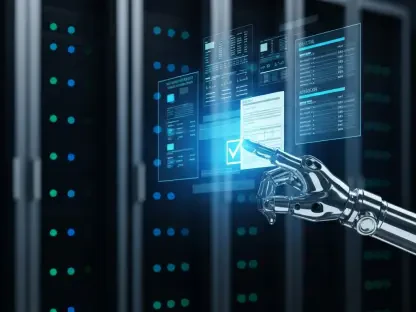In the rapidly changing landscape of data center management, a profound transformation is taking place, driven by the urgent need to keep up with escalating demands for reliability, efficiency, and scalability. Once reliant on manual processes and hands-on troubleshooting, data centers are now pivoting toward automation and Artificial Intelligence for IT Operations (AIOps) to manage increasingly intricate networks. This shift is not merely a passing trend but a critical response to the non-negotiable requirement for constant uptime and seamless performance in modern IT environments. Supported by compelling findings from recent research conducted by Futurum Research in partnership with Nokia, it’s evident that every surveyed organization has embraced at least one form of modern automation, marking the definitive end of purely manual operations. This evolution signifies a new era where smart tools and AI-driven solutions are becoming indispensable in reducing human error and optimizing workflows.
The Universal Shift to Automation Practices
The wave of automation sweeping through data centers is nothing short of revolutionary, with adoption rates reflecting a near-universal consensus on its necessity. Tools that automate monitoring and alerting have become foundational, implemented by 67% of organizations to ensure that routine checks and notifications occur without manual oversight. Similarly, configuration automation platforms like Ansible or Terraform are now in use by 58% of data centers, streamlining the setup and maintenance of complex infrastructures. These tools are not just conveniences; they represent a fundamental change in how IT teams operate, allowing for swift, accurate handling of tasks that once consumed hours of human effort. The complete abandonment of manual-only management, as highlighted by recent industry surveys, underscores that automation is no longer optional but a baseline requirement for staying operational in a competitive landscape.
Beyond these core tools, a broader spectrum of automation practices is emerging to address diverse operational needs. Incident detection powered by AI and machine learning is now utilized by 54% of organizations, enabling faster identification of potential issues before they escalate. Auto-failover systems, adopted by 49%, ensure continuity by automatically switching to backup systems during failures. Additionally, practices inspired by DevOps principles, such as managing network configurations through version control systems (45%) and deploying CI/CD pipelines for network changes (44%), are gaining traction. This diversity in automation approaches illustrates how data centers are customizing solutions to tackle specific challenges, whether it’s minimizing downtime or enhancing deployment speed. The trend points to a maturing industry that recognizes the value of tailored automation in achieving operational excellence.
AIOps as a Game-Changer for Operational Reliability
AIOps is swiftly transitioning from a concept discussed in tech circles to a tangible, widely implemented solution in data center environments. Currently, 43% of organizations have AIOps platforms fully operational, while an additional 31% are in the pilot or deployment phase, reflecting a strong commitment to leveraging AI for IT operations. By analyzing vast datasets in real time, AIOps offers predictive insights that allow teams to address potential disruptions before they impact services. This proactive approach marks a significant departure from traditional reactive troubleshooting, positioning AIOps as a cornerstone of modern data center strategy. The ability to anticipate and mitigate issues not only enhances reliability but also frees up valuable resources for innovation rather than constant firefighting.
Complementing AIOps, other advanced technologies are bolstering data center resilience and efficiency. Network digital twins, which are real-time software models for simulating and testing changes, are in use by 49% of organizations, providing a safe environment to predict outcomes without risking live systems. Intent-based networking, adopted by 50%, allows systems to self-configure based on predefined objectives, reducing manual intervention and the associated risk of errors. These tools collectively aim to create an ecosystem where downtime is minimized, and human mistakes are nearly eliminated. As these technologies become more mainstream, they pave the way for a future where data centers operate with near-autonomous precision, fundamentally redefining expectations for performance and reliability in the industry.
Strategic Imperatives Fueling Automation Adoption
The drive toward automation in data centers transcends mere convenience, emerging instead as a strategic necessity to navigate the complexities of modern IT infrastructure. With networks growing more intricate by the day, IT leaders are prioritizing automation to ensure consistency, scalability, and uninterrupted uptime. Automated scripts and processes offer a significant advantage over manual methods by drastically reducing the likelihood of errors, which can be costly in terms of both time and resources. This focus on precision and speed directly addresses the mounting pressure to maintain continuous operation, especially as businesses increasingly rely on digital services. Automation, in this context, becomes a critical enabler for meeting heightened expectations without compromising on quality or performance.
Moreover, the strategic adoption of automation is often aligned with broader organizational goals beyond the IT department. Reducing operational errors through automated workflows translates into tangible business benefits, such as improved customer experiences and enhanced service reliability. The emphasis on speed also means that updates, patches, and system changes can be rolled out faster, keeping data centers agile in a dynamic market. As complexity continues to escalate, automation serves as a stabilizing force, enabling teams to manage larger, more intricate systems without proportional increases in staff or budget. This alignment of technical capability with business outcomes underscores why automation is viewed not just as a tool, but as a foundational element of long-term data center strategy.
Balancing Innovation with Operational Stability
While the embrace of automation is widespread, the data center industry is also characterized by a spirit of experimentation that pushes technological boundaries. Practices like self-healing networks, currently implemented by 33% of organizations, demonstrate a forward-thinking approach where systems can autonomously detect and resolve issues without human input. Similarly, chaos engineering, used by 20% to test resilience through intentional stress on systems, reflects a bold willingness to innovate. These cutting-edge methods signal an industry not content with the status quo, actively seeking ways to future-proof operations against unpredictable challenges. Such initiatives, though not yet universal, highlight a growing appetite for transformative solutions that could redefine data center management.
At the same time, a strong sense of pragmatism anchors these innovative efforts, ensuring that stability remains a priority. Automated rollback mechanisms, adopted by 60% of organizations, provide a safety net by reverting systems to a previous state if changes go awry. Version-controlled configurations, in use by 58%, offer another layer of security by tracking changes systematically to prevent missteps. This balance between pushing boundaries and maintaining safeguards is evident in the industry’s focus on reliability, with 80% of surveyed professionals emphasizing the importance of pre-check and post-check capabilities for network changes. By blending innovation with caution, data centers are crafting a resilient framework that supports experimentation without risking critical disruptions.
Crafting an Intelligent Automation Framework
A notable trend reshaping data centers is the integration of disparate automation tools into a cohesive, intelligent framework often described as an “automation loop.” This system combines real-time monitoring, rigorous testing, CI/CD pipelines for seamless updates, and AI-driven analytics to continuously validate a network’s alignment with its intended configuration. Such integration drastically cuts the risk of outages by catching anomalies or misconfigurations early, often before they impact live environments. With 80% of industry respondents prioritizing pre-check and post-check validations for network changes, there’s a clear consensus on the need to prevent errors from reaching production. This holistic approach is fast becoming a best practice for ensuring operational integrity.
The rise of this intelligent automation ecosystem reflects a broader vision for data centers as dynamic, software-driven environments where AI and automation play central roles. From foundational monitoring tools to advanced self-managing systems, the range of practices in use illustrates an industry at varying stages of maturity but united by a shared objective: minimizing downtime while maximizing efficiency. As AIOps and related technologies continue to evolve, they enable data centers to handle growing workloads with greater precision, reducing the burden on human operators. This shift toward interconnected, smart systems suggests a future where data centers operate with unprecedented autonomy, setting a new standard for what’s possible in IT infrastructure management.
Reflecting on the Automated Evolution
Looking back, the journey of data centers toward automation and AIOps reveals a remarkable transformation driven by the imperatives of reliability and efficiency. What started as a gradual move away from manual processes evolved into a comprehensive overhaul, with every organization adopting modern tools to navigate the complexities of network management. Technologies like AIOps, network digital twins, and self-healing systems, once considered experimental, became integral to maintaining uptime and performance. This shift, supported by strategic investments in intelligent automation loops, demonstrated how the industry adapted to meet escalating demands with precision and foresight.
For data center operators and IT leaders, the path forward involves prioritizing high-impact automation initiatives that align with measurable business outcomes, such as reduced outages or faster deployments. Embracing advanced practices is no longer a luxury but a necessity to remain competitive in a landscape where innovation and stability go hand in hand. The focus shifts to building robust frameworks that integrate AI and automation seamlessly, ensuring scalability for future challenges. This evolution underscores a pivotal lesson: proactive investment in smart technologies is the key to sustaining operational excellence in an ever-changing digital world.









